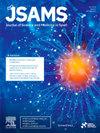肌结缔组织损伤的严重程度分级和重返赛场预测:范围综述。
IF 3
2区 医学
Q1 SPORT SCIENCES
引用次数: 0
摘要
目的进行系统性文献检索,确定目前使用的成人运动中急性非接触性肌肉损伤的分类方法:方法:系统性文献检索:从 2010 年 1 月 1 日至 2022 年 4 月 19 日对 Medline 和 SPORTDiscus 进行系统性文献检索,筛选出 13,426 篇合格文章。对纳入研究的结果进行了定性综合。结果:结果:从纳入的 37 项研究中确定了 24 个分类,其中大部分研究的设计证据不足。大多数分类(57%)是在 2009 年之后发布的,而且大多是针对腿筋或其他下肢损伤制定的。被引用最多的六种分类占报告总数的 70%(BAMIC、修订版 Peetrons、慕尼黑、Cohen、Chan 和 MLG-R)。结果报告很少,因此很难得出结论。不过,BAMIC、改良 Peetrons、Munich 和 Cohen 分类的分级与恢复比赛时间之间的关系还是很明显的。其他分级要么报告的相关性极少,要么报告没有相关性,要么报告不确定的相关性,要么没有报告对相关性的评估。对其他结果的调查也不充分:结论:对肌肉分类的使用尚未达成一致,对定义和术语也未达成共识。因此,各研究报告的结果及其与严重程度分级的关系并不一致。有必要提高现有分类的普遍性和适用性,并完善其预后价值。要解决这些不一致问题,需要进行高级别证据研究。本文章由计算机程序翻译,如有差异,请以英文原文为准。
Classification of myo-connective tissue injuries for severity grading and return to play prediction: A scoping review
Objectives
To conduct a systematic literature search to identify currently used classifications of acute non-contact muscle injuries in sporting adults.
Designs
Scoping review.
Methods
A systematic literature search from January 1, 2010 to April 19, 2022 of Medline and SPORTDiscus yielded 13,426 articles that were screened for eligibility. Findings from included studies were qualitatively synthesized. Classifications and their grading, as well as outcomes and definitions were extracted.
Results
Twenty-four classifications were identified from the 37 included studies, most of which had low evidence study designs. Majority (57 %) of classifications were published after 2009 and were mostly developed for hamstring or other lower limb injuries. The six most cited classifications accounted for 70 % of the reports (BAMIC, modified Peetrons, Munich, Cohen, Chan and MLG-R). Outcome reporting was sparse, making it difficult to draw conclusions. Still, significant relationships between grading and time to return to play were reported for the BAMIC, modified Peetrons, Munich and Cohen classifications. Other classifications either had a very low number of reported associations, reported no associations, reported inconclusive associations, or did not report an assessment of the association. Other outcomes were poorly investigated.
Conclusions
There is no agreed-upon use of muscle classification, and no consensus on definitions and terminology. As a result, reported outcomes and their relationship to severity grading are inconsistent across studies. There is a need to improve the generalizability and applicability of existing classifications and to refine their prognostic value. High-level evidence studies are needed to resolve these inconsistencies.
求助全文
通过发布文献求助,成功后即可免费获取论文全文。
去求助
来源期刊
CiteScore
7.40
自引率
10.00%
发文量
198
审稿时长
48 days
期刊介绍:
The Journal of Science and Medicine in Sport is the official journal of Sports Medicine Australia (SMA) and is an an international refereed research publication covering all aspects of sport science and medicine.
The Journal considers for publication Original research and Review papers in the sub-disciplines relating generally to the broad sports medicine and sports science fields: sports medicine, sports injury (including injury epidemiology and injury prevention), physiotherapy, podiatry, physical activity and health, sports science, biomechanics, exercise physiology, motor control and learning, sport and exercise psychology, sports nutrition, public health (as relevant to sport and exercise), and rehabilitation and injury management. Manuscripts with an interdisciplinary perspective with specific applications to sport and exercise and its interaction with health will also be considered.

 求助内容:
求助内容: 应助结果提醒方式:
应助结果提醒方式:


